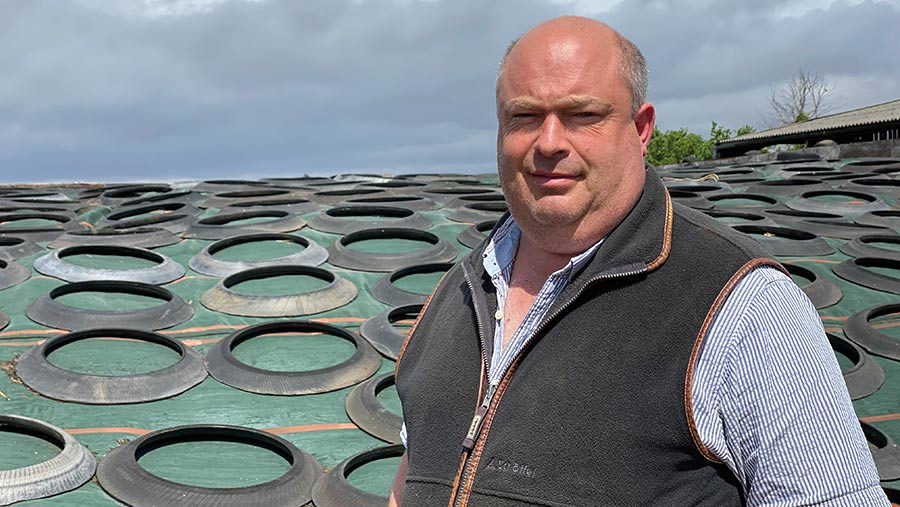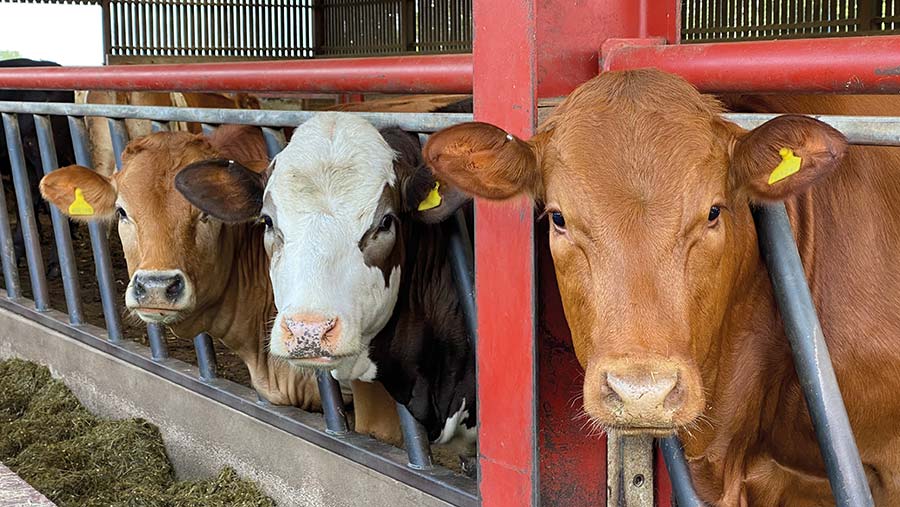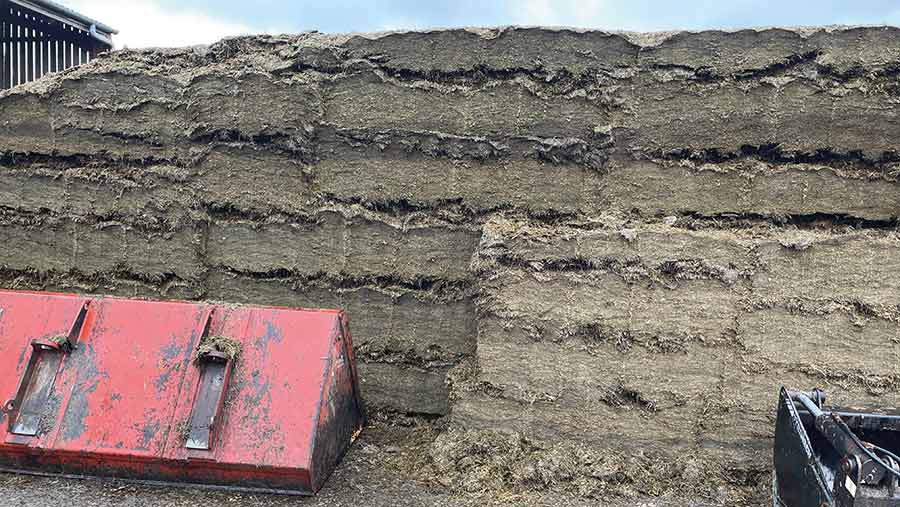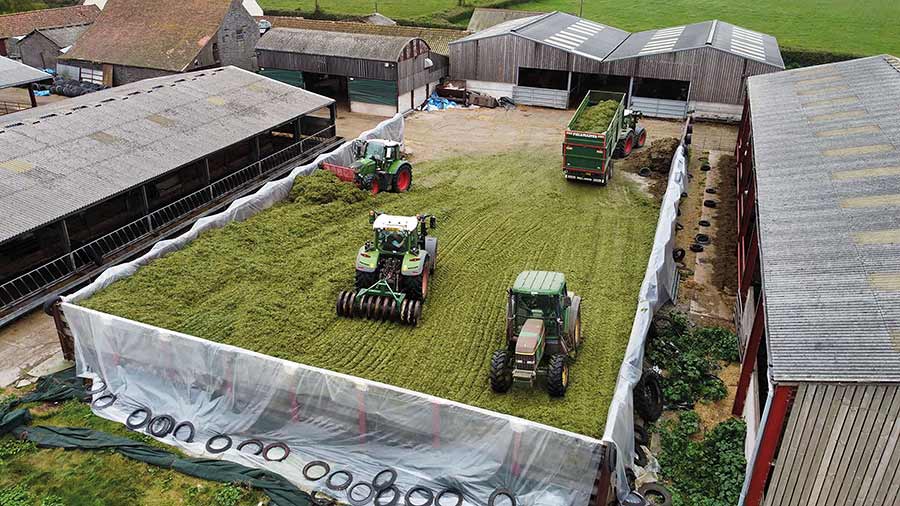How one farmer is cutting out concentrates to secure future for beef
 Jonathan Guilding © Ann Hardy
Jonathan Guilding © Ann Hardy The cost of rations has always been critical to the profitability of the beef enterprise on Jonathan Guilding’s Somerset farm.
But this year, in the face of spiralling feed prices, it has become a matter of make or break.
Until this year, Mr Guilding has always forward-bought about 150t of an 18% protein blend, for which he has paid up to £213/tonne.
This has been fed to the 500 cattle he runs, alongside his arable business, on the 202ha (500-acre) tenanted Culver Street Farm.
See also: Advice on building a new silage clamp
Using this system has always kept the cost of his rations lower than that of many producers.
However, for 2022, he says the price quoted for the same product was £363/tonne, which would have made the continuation of the beef enterprise untenable under this system of feeding.
So, instead of looking to concentrates, he is tapping into his proven ability to make top-quality forage.
He now aims to finish his dairy cross beef cattle with little, if any, bought-in feed. And, as well as removing the blend from the ration, he hopes to cut out the home-grown wheat.
The success of this strategy depends entirely on making the highest quality grass silage – something last year’s analysis would suggest can be achieved.
To this, he will add maize silage, which he has previously grown for anaerobic digestion, but never for forage.
Farm facts
Culver Street Farm, Somerset
- 202ha (500-acre) arable and beef tenancy using family labour and contractors
- Throughput of 500 beef a year bought at 4-14 months and sold at 18-20 months
- Purchase continentals (British Blue, Limousin and Simmental) and Angus from dairy herds
- Deadweights of 320kg (heifers), 360kg (steers) at grades of mostly O+ 3+/4L and R+ 3/-4L
Complementary silages
According to his independent nutritionist, Rob Mintern, if made to a high standard, the two forages will complement each other well and could provide all the crude protein and energy his stock require.
He says: “A mix of maize and grass silage can potentially supply all the energy, starch, sugar, protein and fibre required, but both forages would need to analyse well, including with a metabolisable energy [ME] of 12MJ/kg dry matter [DM].”
The grass silage would also need to hit a crude protein level of 15-17%. If that can be achieved, then not much else would be needed to achieve good growth rates in a cost-effective way, he says.
Suggesting a mix of grass and maize silage of around 50:50, fed at freshweights of 18kg each, Mr Mintern says this should make daily liveweight gains of 1.4kg in the grower ration, assuming a diet with an ME of 12.1MJ/kg DM.
An analysis of Mr Guilding’s 2021 grass silage, at 12.1MJ/kg DM ME, 17.9% protein, a D-value of 75.8, together with low-ammonia nitrogen, 43.9% DM and excellent fermentation characteristics, gives confidence in this strategy.

© Ann Hardy
However, achieving this analysis in 2022 will require strict rules to be followed, weather conditions on his side, and everything going to plan. This applies to maize and grass.
Mr Mintern recommends choosing maize varieties with starch over 35% and an ME of more than 11.8. Mr Guilding is growing Limagrain’s variety Prospect.
Grass varieties are equally critical. On Culver Street Farm, much of the grass silage production is based on short-term leys of modern Italian, perennial and hybrid ryegrasses which are only down for 24 months.
Multi-cuts
Taking multi-cuts is key to success as it means the grass being harvested for the farm’s three cuts will always be young.
Silaging began this year on 21 April, is repeated at five-weekly intervals – subject to suitable analysis and conditions – and third cut aftermaths are allocated to grazing.
“Taking multi-cuts is a mindset thing,” says Mr Guilding. “It took me a while to get over the need for big yields, but you soon see the saving in concentrate.”

© Ann Hardy
Sampling
There are many potential slips which could compromise quality, with unfavourable weather being the greatest threat.
Standing samples are taken before the grass is mown, and Mr Guilding says indications are that protein will be lower in first cut this year.
In addition, some of this year’s second cut had to be delayed by a week because dry weather impeded nitrogen fertiliser uptake.
“By the time we cut a week later, protein percentage had dropped by three points,” he says.
However, key to the rationing will be core samples, taken before and during winter feeding, which will reveal how the grass silage should be balanced.
“The maize crop is looking good at this stage, and we hope this will be all that’s required,” he says. “But if we do have to buy anything in, it will be straights rather than a blend, and it will all be done on spot price.”
Mr Guilding forecasts “substantial” savings by switching to forage, adding: “This will make the difference between survival and failure for the cattle side of our business.”
Silage-making protocols at Culver Street Farm

© Jack Guilding
Protocols for silage-making are crucial for success at Culver Street Farm, and management of the pit is key.
Compaction Jonathan Guilding closely monitors filling of the silage pit, pacing the arrival of trailers to ensure each layer is thoroughly compacted and air excluded, which is particularly challenging in his high-DM crops.
“We use a [4t] SilaPactor on the clamp which literally makes tonnes of difference to the amount of silage we get into the pit,” he says.
As well as saving on the storage space required, this practice excludes air, reducing the chance of aerobic spoilage and increasing the density of the silage by as much as 40%.
Preservative Mr Guilding also uses a preservative containing high concentrations of human food-grade sodium benzoate and potassium sorbate to eliminate the growth of yeast and mould, and sodium nitrite to kill off undesirable bacteria such as clostridia and enterobacteria.
Providing a clean environment for lactic acid bacteria achieves a rapid reduction of pH, according to feed and forage preservation specialist Kelvin Cave, who produces Mr Guilding’s forage analysis reports.
“This eliminates the risk of butyric acid production which would lower the nutritional value and palatability,” he says.
Sheeting In both instances, he is also meticulous with his sheeting, using heavy-gauge side-sheets, an oxygen-impermeable top sheet, clamp netting to protect against bird damage and tyre rings – which do not hold water and contain no metal – to weigh down the clamp.
Attention to detail is just as important for both crops, and Mr Guilding says he will follow the same protocols when he preserves his maize.
The numbers
- 12.1 Metabolisable energy of first-cut grass silage in 2021 (MJ/kg DM)
- 17.9% Crude protein percentage of first-cut grass silage in 2021
- 75.8 Digestibility value of first-cut grass silage in 2021
- 21 Date of first-cut silage in April 2022
- 3 Number of cuts of silage taken each year
- 5 Target number of weeks between cuts
